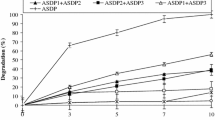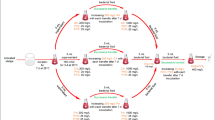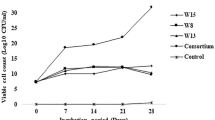Abstract
In the present study, a defined consortium of Pseudomonas sp. MO2A and Debaryomyces maramus CW36 was studied to assess their potential for enhancing degradation and detoxification of polychlorinated biphenyls (PCBs) in liquid medium. The optimum pH of the medium was 6.0 for PCB degradation by the consortium. At this pH, the coculture of the bacterium and the yeast showed promoted PCB degradation (69.6 % in 14 days) under aerobic conditions. Under the same conditions, Pseudomonas sp. MO2A and Debaryomyces maramus CW36 showed only 57.0 and 27.8 % degradation of PCBs, respectively. The addition, appropriate amounts of glucose or biphenyl could enhance PCB biodegradation. However, Tween 80 showed no stimulatory effect on PCB biodegradation at any level applied (5–30 mg/L). The highest removal and dechlorination efficiencies of PCBs were 92.6 and 61.4 %, respectively, on the 14th day using the coculture. The results of toxicity studies suggested that this consortium may be effectively used for detoxification of PCBs due to their complementary role in degradation of toxic intermediates. Our results showed that the use of bacteria-yeast coculture was more effective for PCB degradation than any single culture and has potential environmental implications in cleaning up PCB polluted environments.





Similar content being viewed by others
References
Basak B, Bhunia B, Dutta S, Chakraborty S, Dey A (2014) Kinetics of phenol biodegradation at high concentration by a metabolically versatile isolated yeast Candida tropicalis PHB5. Environ Sci Pollut Res 21:1444–1454
Bidlan R, Manonmani HK (2002) Aerobic degradation of dichlorodiphenyltrichloroethane (DDT) by Serratia marcescens DT-1P. Process Biochem 38:49–56
Chang YC, Takada K, Choi D, Toyama T, Sawada K, Kikuchi S (2013) Isolation of biphenyl and polychlorinated biphenyl-degrading bacteria and their degradation pathway. Appl Biochem Biotechnol 170:381–398
Chun CL, Payne RB, Sowers KR, May HD (2013) Electrical stimulation of microbial PCB degradation in sediment. Water Res 47:141–152
Čvančarová M, Křesinová Z, Filipová A, Covino S, Cajthaml T (2012) Biodegradation of PCBs by ligninolytic fungi and characterization of the degradation products. Chemosphere 88:1317–1323
Fang H, Dong B, Yan H, Tang F, Yu Y (2010) Characterization of a bacterial strain capable of degrading DDT congeners and its use in bioremediation of contaminated soil. J Hazard Mater 184:281–289
Gomes HI, Dias-Ferreira C, Ribeiro AB (2013) Overview of in situ and ex situ remediation technologies for PCB-contaminated soils and sediments and obstacles for full-scale application. Sci Total Environ 445–446:237–260
Gottfried A, Singhal N, Elliot R, Swift S (2010) The role of salicylate and biosurfactant in inducing phenanthrene degradation in batch soil slurries. Appl Microbiol Biotechnol 86:1563–1571
He YM, Duan XG, Liu YS (2014) Enhanced bioremediation of oily sludge using co-culture of specific bacterial and yeast strains. J Chem Technol Biotechnol 89:1785–1792
Hesham AEL, Khan S, Tao Y, Li D, Zhang Y, Yang M (2012) Biodegradation of high molecular weight PAHs using isolated yeast mixtures: application of meta-genomic methods for community structure analyses. Environ Sci Pollut Res 19:3568–3578
Kohler HP, Kohler-Staub D, Focht DD (1988) Cometabolism of polychlorinated biphenyls: enhanced transformation of Aroclor 1254 by growing bacterial cells. Appl Environ Microbiol 54:1940–1945
Lade HS, Waghmode TR, Kadam AA, Govindwar SP (2012) Enhanced biodegradation and detoxification of disperse azo dye Rubine GFL and textile industry effluent by defined fungal-bacterial consortium. Int Biodeterior Biodegrad 72:94–107
Liu H, Yu QJ, Wang G, Ye F, Cong Y (2011) Biodegradation of phenol at high concentration by a novel yeast Trichosporon montevideense PHE1. Process Biochem 46:1678–1681
Liz JAZE, Jan-Roblero J, de la Serna JZD, de León AVP, Hernández-Rodríguez C (2009) Degradation of polychlorinated biphenyl (PCB) by a consortium obtained from a contaminated soil composed of Brevibacterium, Pandoraea and Ochrobactrum. World J Microbiol Biotechnol 25:165–170
Lu M, Zhang Z, Qiao W, Guan Y, Xiao M, Peng C (2010) Removal of residual contaminants in petroleum-contaminated soil by Fenton-like oxidation. J Hazard Mater 179:604–611
Lu M, Zhang ZZ, Wu XJ, Xu YX, Su XL, Zhang M (2013) Wang JX, Biodegradation of decabromodiphenyl ether (BDE-209) by a metal resistant strain Bacillus cereus JP12. Bioresour Technol 149:8–15
Magalhães KT, Pereira GVM, Dias DR, Schwan RF (2010) Microbial communities and chemical changes during fermentation of sugary Brazilian kefir. World J Microbiol Biotechnol 33:1–10
Mouhamadou B, Faure M, Sage L, Marçais J, Souard F, Geremia RA (2013) Potential of autochthonous fungal strains isolated from contaminated soils for degradation of polychlorinated biphenyls. Fungal Biol 117:268–274
Petrik J, Drobna B, Pavuk M, Jursa S, Wimmerova S, Chovancova J (2006) Serum PCBs and organochlorine pesticides in Slovakia: age, gender, and residence as determinants of organochlorine concentrations. Chemosphere 65:410–418
Pieper DH (2005) Aerobic degradation of polychlorinated biphenyls. Appl Microbiol Biotechnol 67:170–191
Robidoux PY, Gong P, Sarrazin M, Bardai G, Paquet L, Hawari J, Dubois C, Sunahara GI (2004) Toxicity assessment of contaminated soils from an antitank firing range. Ecotox Environ Saf 58:300–313
Sietmann R, Gesell M, Hammer E, Schauer F (2006) Oxidative ring cleavage of low chlorinated biphenyl derivatives by fungi leads to the formation of chlorinated lactone derivatives. Chemosphere 64:672–685
Wang CC, Lee CM, Lu CJ, Chuang MS, Huang CZ (2000) Biodegradation of 2,4,6-trichlorophenol in the presence of primary substrate by immobilized pure culture bacteria. Chemosphere 41:1873–1879
Wong CS, Mabury SA, Whittle DM, Backus SM, Teixeira C, DeVault DS, Bronte CR, Muir DCG (2003) Organochlorine compounds in lake superior: chiral polychlorinated biphenyls and biotransformation in the aquatic bood web. Environ Sci Technol 38:84–92
Wong JWC, Fang M, Zhao Z, Xing B (2004) Effect of surfactants on solubilization and degradation of phenanthrene under thermophilic conditions. J Environ Qual 33:2015–2025
Xu L, Teng Y, Li ZG, Norton JM, Luo YM (2010) Enhanced removal of polychlorinated biphenyls from alfalfa rhizosphere soil in a field study: the impact of a rhizobial inoculum. Sci Total Environ 408:1007–1013
Yin Y, Guo J, Zheng L, Tian L, Wang X (2011) Capability of polychlorinated biophenyl (PCBs) degrading fungi segregated from sediments. World J Microbiol Biotechnol 27:2567–2574
Zhang D, Zhu L (2012) Effects of Tween 80 on the removal, sorption and biodegradation of pyrene by Klebsiella oxytoca PYR-1. Environ Pollut 164:169–174
Zhou J, Jiang W, Ding J, Zhang X, Gao S (2007) Effect of tween 80 and β-cyclodextrin on degradation of decabromodiphenyl ether (BDE-209) by white Rot fungi. Chemosphere 70:172–177
Acknowledgments
This work was funded by the Key Projects in the National Science & Technology Pillar Program during the Twelfth 5-year Plan Period (2012BAB11B06), and the Priority Academic Program Development of Jiangsu Higher Education Institutions (PAPD).
Author information
Authors and Affiliations
Corresponding author
Rights and permissions
About this article
Cite this article
Chen, F., Hao, S., Qu, J. et al. Enhanced biodegradation of polychlorinated biphenyls by defined bacteria-yeast consortium. Ann Microbiol 65, 1847–1854 (2015). https://doi.org/10.1007/s13213-014-1023-8
Received:
Accepted:
Published:
Issue Date:
DOI: https://doi.org/10.1007/s13213-014-1023-8




